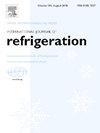Research of CO2 high temperature heat pump for industrial steam generation with data center heat source
IF 3.5
2区 工程技术
Q1 ENGINEERING, MECHANICAL
International Journal of Refrigeration-revue Internationale Du Froid
Pub Date : 2025-02-13
DOI:10.1016/j.ijrefrig.2025.02.014
引用次数: 0
Abstract
The solution of integrating large-scale high-temperature heat pump (HTHP) with data center not only reduces carbon emissions but also enhances energy efficiency, aligning with dual-carbon goals. However, pressure ratios and environmentally friendly refrigerants limit the conventional HTHPs. Therefore, this paper proposes an improved transcritical CO2 HTHP steam system (CO2-NC) with dual-pressure gas coolers and expander. Detailed thermodynamic analysis, exergy analysis, and economic analysis are conducted to evaluate the cycle performance. Compared to the conventional CO2 cycle, the COP of CO2-NC is improved by 32.7 %, and the pressure ratio is reduced by 13.22 %, with a 110 °C saturated steam supply. With the superior thermal matching performance of dual-pressure gas coolers, the irreversible loss of gas coolers in CO2-NC is diminished by 75.89 %. The total pressure ratio of CO2-NC is less than 1/4 of that in the conventional cycles with HFC/HFO refrigerants, providing an advantage in large-scale HTHPs with centrifugal compressors. Exergy analysis highlights that the expander in the CO2-NC decreases irreversible losses in the expansion process by 81.27 %. CO2-NC with the least variation in COP and pressure ratio shows excellent adaptability to data center heat sources, and CO2-NC exhibits the least variation with changes in saturated steam temperature. Furthermore, the optimum compressor discharge pressure for CO2 HTHPs is analyzed. Economic analysis highlights the advantages of CO2-NC in operation and refrigerant costs with the constraints of high initial capital costs. This study emphasizes the potential of combining transcritical CO2 HTHP to fulfill data center cooling and industrial heating needs.
数据中心热源用于工业蒸汽产生的CO2高温热泵研究
将大型高温热泵(HTHP)与数据中心集成的解决方案,既减少了碳排放,又提高了能源效率,符合双碳目标。然而,压力比和环保制冷剂限制了传统的HTHPs。为此,本文提出了一种采用双压气体冷却器和膨胀器的改进型跨临界CO2高温高压蒸汽系统(CO2- nc)。对循环性能进行了详细的热力学分析、火用分析和经济分析。与常规CO2循环相比,在110℃饱和供汽条件下,CO2- nc循环的COP提高了32.7%,压比降低了13.22%。由于双压力气体冷却器具有良好的热匹配性能,使气体冷却器在CO2-NC中的不可逆损失降低了75.89%。CO2-NC的总压比小于HFC/HFO制冷剂常规循环的1/4,在大型离心式压缩机高温高压发电站中具有优势。火用分析表明,在CO2-NC中加入膨胀剂后,膨胀过程中的不可逆损失降低了81.27%。COP和压力比变化最小的CO2-NC对数据中心热源具有良好的适应性,且CO2-NC对饱和蒸汽温度的变化最小。进一步分析了CO2高温高压热泵压缩机的最佳排气压力。经济分析强调了CO2-NC在运行和制冷剂成本方面的优势,但受到初始资本成本高的限制。这项研究强调了结合跨临界CO2 HTHP来满足数据中心冷却和工业加热需求的潜力。
本文章由计算机程序翻译,如有差异,请以英文原文为准。
求助全文
约1分钟内获得全文
求助全文
来源期刊
CiteScore
7.30
自引率
12.80%
发文量
363
审稿时长
3.7 months
期刊介绍:
The International Journal of Refrigeration is published for the International Institute of Refrigeration (IIR) by Elsevier. It is essential reading for all those wishing to keep abreast of research and industrial news in refrigeration, air conditioning and associated fields. This is particularly important in these times of rapid introduction of alternative refrigerants and the emergence of new technology. The journal has published special issues on alternative refrigerants and novel topics in the field of boiling, condensation, heat pumps, food refrigeration, carbon dioxide, ammonia, hydrocarbons, magnetic refrigeration at room temperature, sorptive cooling, phase change materials and slurries, ejector technology, compressors, and solar cooling.
As well as original research papers the International Journal of Refrigeration also includes review articles, papers presented at IIR conferences, short reports and letters describing preliminary results and experimental details, and letters to the Editor on recent areas of discussion and controversy. Other features include forthcoming events, conference reports and book reviews.
Papers are published in either English or French with the IIR news section in both languages.

 求助内容:
求助内容: 应助结果提醒方式:
应助结果提醒方式:


